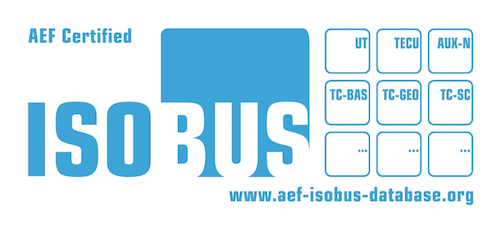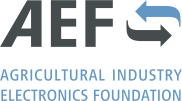Picture this scenario: a manufacturer makes a tractor. A farmer feels it’s perfect for him, and he buys it. Then, he needs an implement for his tractor. He finds a brand he likes from a different manufacturer, and he buys it. Then, he buys his favorite display from another manufacturer. Sounds fine, right? Sure, except if the products aren’t compatible with each other, they won’t work together at all.
With so many different manufacturers creating a wide scope of agricultural products available on the market today, this is a fairly common problem for the North American farmer. However, when products all share the same “nerve system,” more commonly referred to as the CANbus, they communicate seamlessly.
Using a common language allows the farmer to use a single display to operate any implement that is connected to his tractor. This includes implement set up and basic operation, as well as more advanced operations necessary for precision farming, such as automatic section control (based on overlap) and prescription maps, to automatically vary the application rate based on GPS position.
But how did this CANbus come about, and why is it so important for the industry to understand?
ISOBUS: Why it Plugged and Failed Two Decades Ago
ISOBUS is the commonly used name referring to an ISO standard (ISO 11783 - Tractors and machinery for agriculture and forestry – Serial control and communications data network) which was first released in the late 90s. It describes electronic communication via a common CANbus between tractor and implements. Manufacturers were promoting the first ISOBUS products almost two decades ago at the Agritechnica exhibition in Hannover, Germany in 2001.
The original intention behind ISOBUS was for different equipment, electronics and software to work harmoniously together. But communication between tractors, implements and displays from different manufacturers did not always work trouble-free due to missing definitions in the ISO 11783 standard.
Farmers were confronted with ISOBUS solutions which were not compatible, and quickly found that the “plug-and-play promise” of ISOBUS had not been realized.
Who is the Agriculture Industry Electronics Foundation (AEF)?
The Agriculture Industry Electronics Foundation (AEF) was founded in October 2008 by seven agricultural equipment manufacturers and two trade associations who all agreed to cooperate on a voluntary basis to help the industry work with ISOBUS and solve the issues seen by the farmers.
The AEF set about defining ISOBUS in terms of individual functionalities to enable everybody to understand what you could actually do with an ISOBUS system, typically (but not limited to) a tractor/implement/display combination
They then defined a conformance test for those functionalities. They also created a database where any farmer can quickly see all of the ISOBUS products that have passed the conformance test.
AEF ISOBUS Conformance Test and Database
The AEF developed a new, highly automated, “AEF ISOBUS Conformance Test” for the certification of ISOBUS products. The Conformance Test confirms that the ISOBUS product being tested complies with the ISOBUS standard and complies with the AEF Functionality Guidelines. In other words, the Conformance Test is an indication of ISOBUS compatibility. Products that pass the test are referred to as “AEF ISOBUS Certified.”
The AEF Certified label decal can be applied to these products and is seen as a sign of quality (see Figure 1)
Manufacturers of ISOBUS products are responsible for getting AEF ISOBUS Certification by one of the licensed testing houses. Luckily there are five testing houses spread around the world which are authorized to run the AEF ISOBUS Conformance Test. One is the Nebraska Tractor Test Laboratory in Lincoln, Neb.
Once the product has passed the AEF ISOBUS Conformance Test, the manufacturer’s product is published in the AEF ISOBUS Database.

Figure 1: The AEF Certified Label
A Seal of Approval
The benefits of recommending and selling products which are AEF ISOBUS certified should not be underestimated.
AEF ISOBUS Certification is a sign of quality, so for the farmer it provides purchase security as well as the potential for higher resale value. They can be certain that the ISOBUS product which is being purchased will be compatible with other certified ISOBUS products that are already owned. In addition, the next owner can benefit for the same reason of known compatibility.
Using only AEF ISOBUS Certified products means there is less potential for problems in the farmyard during equipment preparation time. Lack of any compatibility issues will give the farmer confidence in the reliability of the ISOBUS system being used and field work can be completed on time, ultimately saving the farmer time and money.
From the point of view of the dealership, having ISOBUS products that are AEF ISOBUS certified means salespeople can have confidence when recommending and selling those products. In addition, technicians will spend less time having to provide support to those farmers who are using AEF ISOBUS certified products due to compatibility issues. This all leads to greater satisfaction on behalf of the farmer.
It is only by using AEF ISOBUS Certified products that the farmer truly realizes the “Plug and Play” promise of ISOBUS and takes advantage of the precision farming features on the implements that are so common today.
About the Author: This article is the first in a series of eight by the Agricultural Industry Electronics Foundation (AEF), an independent organization founded on October 28th, 2008 by seven international ag equipment manufacturers and two associations. Today eight manufacturers and three associations are working as core members together with 220 general members. They work to improve cross-manufacturer compatibility of electronic and electric components in agricultural equipment, and to establish transparency about compatibility issues. You can become a member and learn more about the AEF by visiting: www.aef-online.org/home.html or contact the AEF communications team: andrew.olliver@aef-online.org or ryan.milligan@aef-online.org
The Precision Ag - What's under the ISOBUS hood? series is brought to you by the AEF.
The AEF Mission — The development and support for the implementation of generally accepted standards for electric and electronic interfaces as well as standards for data exchange for the agricultural machinery industry. The AEF is providing a framework for the cooperation of all interested parties under the leadership of the core members whilst maintaining competition amongst all members. The AEF supports standardization organizations such as the International Standards Organization (ISO)






